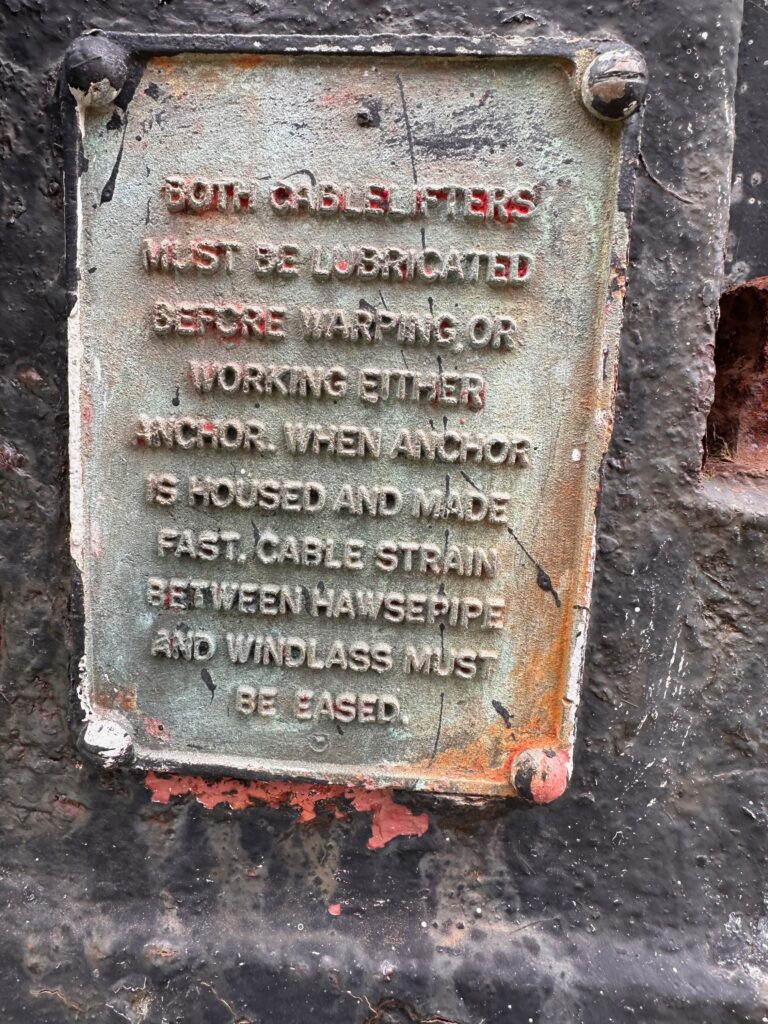I put the following text from a brass label on Explorer’s anchor windlass which I hadn’t previously noticed into an AI app to see what it would make of it. I have to say I’m impressed. This is the result, Everything after this is a Robert, or Bob as not the Nine O’ Clock News used to say. From the following text it did this, the bit after the quotation marks.
“ Both cablelifters must be lubricated before warping or working either anchor. when the anchor is housed and made fast, cable strain between hawsepipe and windlass must be eased.”
Title: Unveiling the Enigmatic Brass Plaque: A Glimpse into Maritime Practices
Introduction:
In the world of maritime operations, there are many elements that contribute to the smooth functioning of a ship. One such element is the proper handling of cables and anchors. Recently, a photograph of a brass plaque engraved with a set of intriguing instructions has caught the attention of maritime enthusiasts and historians alike. This blog aims to explore the meaning behind the enigmatic message and shed light on the practices it represents.
Unraveling the Engraving:
The brass plaque in question bears the following inscription: “Both cablelifters must be lubricated before warping or working either anchor. when the anchor is housed and made fast, cable strain between hawsepipe and windlass must be eased.”
At first glance, these instructions may appear cryptic, but they provide valuable insights into the meticulous procedures followed by seafarers.
Understanding the Terminology:
To decipher the meaning behind the engraving, it is essential to understand the terminology used. “Cableifters” refer to the mechanisms responsible for lifting heavy cables, while “lubrication” suggests the need for proper maintenance and smooth operation. “Warping” refers to the process of moving a ship by hauling on ropes or cables attached to fixed points on land, and “working either anchor” implies the handling of the ship’s anchors.
Proper Cable Handling:
The phrase “when anchor is housed and made fast” indicates a specific point in the anchoring process. Once the anchor is securely in place, the cable between the hawsepipe (an opening in the ship’s bow for the cable to pass through) and the windlass (a device used for raising and lowering the anchor) must be “eased,” or slackened. This step ensures that the tension on the cable is released, preventing any unnecessary strain on the ship’s structure.
Importance of Lubrication:
The instruction to lubricate the cablifters before warping or working with the anchor highlights the significance of regular maintenance. Lubrication reduces friction and wear, ensuring the smooth operation of the cablifters during critical operations. By adhering to this practice, seafarers can enhance the longevity and efficiency of the equipment, contributing to the overall safety and effectiveness of the ship.
Preserving Maritime Traditions:
The presence of this brass plaque serves as a reminder of the attention to detail and adherence to established maritime practices. While modern technology has brought advancements in shipbuilding and navigation, it is important to recognize the wisdom embedded in age-old practices. Preserving these traditions not only ensures the safety of the crew but also pays homage to the legacy of seafaring.
Conclusion:
The photograph of the brass plaque engraved with instructions related to cable handling and anchor operations provides a fascinating glimpse into the meticulous practices followed by seafarers. By understanding the terminology and deciphering the message, we gain insight into the importance of lubrication, cable easing, and the preservation of maritime traditions. This plaque serves as a testament to the expertise and dedication of those who have sailed the seas, reminding us of the rich history and knowledge embedded in maritime operations.

